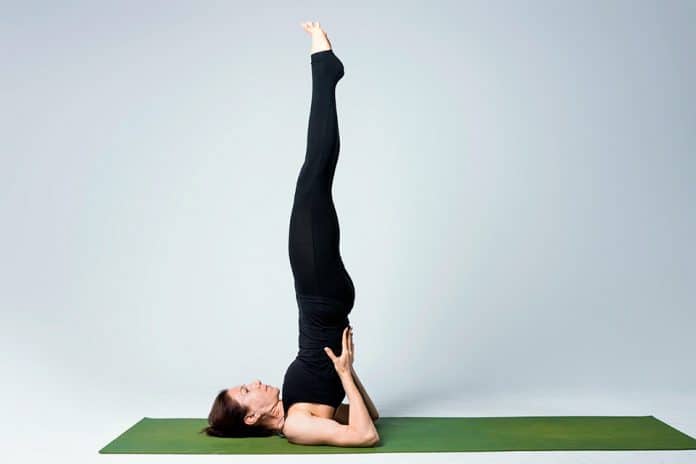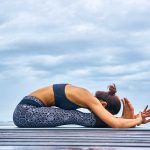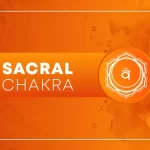Best Practice of Sarvangasana. One of the opening stances in the series of inverted poses is Sarvangasana. You will have a sense of mental and physical calm after doing it.
Let’s examine what the inversion action of Sarvangasana means and how it functions in order to appreciate its beauty and all of its advantages.
What is the practice of Sarvangsana?
The practice of Sarvangasana, also known as Shoulderstand, is a yoga pose that involves balancing the body on the shoulders with the support of the hands. “Sarvangasana” is derived from the Sanskrit words “sarva” meaning “all” and “Pangasinan” meaning “pose,” indicating that it is a pose that benefits the entire body.
In Sarvangasana, the body is inverted, with the legs extended upward and the torso supported by the hands on the back. The shoulders, neck, and upper back bear the weight of the body, while the legs and lower body are lifted vertically. The gaze is typically directed toward the toes or the chest.
Sarvangasana is considered an intermediate to advanced yoga pose and is often included in Hatha, Iyengar, and Ashtanga yoga practices. It offers numerous benefits, including:
- Improved circulation: Inverting the body stimulates blood flow towards the upper body, promoting better circulation and oxygenation of the brain and vital organs.
- Calming and balancing effect: Sarvangasana activates the parasympathetic nervous system, which induces a state of relaxation, reduces stress, and improves overall mental well-being.
- Strengthening of the shoulders and upper back: The pose engages the muscles in the shoulders, upper back, and arms, helping to build strength and stability in these areas.
- Stimulation of the thyroid gland: Sarvangasana applies gentle pressure on the thyroid gland, which can help regulate its function and balance the body’s metabolism.
- Improved digestion and elimination: The pose can enhance digestion and relieve constipation by facilitating the movement of the abdominal organs and stimulating the digestive system.
It is important to practice Sarvangasana under the guidance of a qualified yoga instructor, especially for beginners, to ensure proper alignment, technique, and safety. Individuals with neck or shoulder injuries, high blood pressure, or other health conditions should consult with a healthcare professional before attempting Sarvangasana.
Meaning
Sarvangasana is also known as Salamba Sarvangasana in Sanskrit.
Salamba Sarvangasana is a word that combines the following two:
- Salamba means “with assistance” (Sa with + alamba).
- Sarvangasana is a stance that “comprises all bodily limbs” (Sarva – all + Аnga – limb + asana – pose).
In this pose, the hands and shoulders support the back’s inverted position while the entire body benefits from it. Salamba Sarvangasana, Supported Shoulder Stand, is the name given to it.
In Sarvangasana, the shoulder serves as the main limb on which the body is supported. In addition to the shoulder, the neck is also strongly related to it, therefore when pressure is applied to the shoulders in this pose, the thyroid gland in the neck is also stimulated. Since the thyroid gland regulates metabolism, limb growth, and development, this pose benefits every region of the body at once. Given that the shoulder supports the entire body in Sarvangasana, it is simple to comprehend how this pose is beneficial for all body limbs.
Shoulder stand – Mother of Asanas
This pose aims for the same harmony and happiness that a mother seeks for her family and the human system as a whole.
BKS Iyengar and Yoga in Light
Additionally, it is stated in his book that Sarvangasana should be mastered before beginning to practice Sirsasana (headstand). It resembles a practice session for an introductory lesson before moving on to a higher level. Consequently, in contrast to Headstand, which is referred to as the father or King of asanas, Sarvangasana serves as a prerequisite for inversion positions and is therefore known as the mother or queen of asanas.
The T. Krishnamacharya lineage popularized the shoulder stand stance in its contemporary form, but the 15th-century work Hatha Yoga Pradipika also mentions a comparable posture known as Viparita Karani. It implies that something has been done since the beginning of time.
In addition to this, Sarvangasana is mentioned in the Gheranda Samhita from the 17th century and the Shiv Samhita from the 14th century.
Sarvangasana Practice Guide
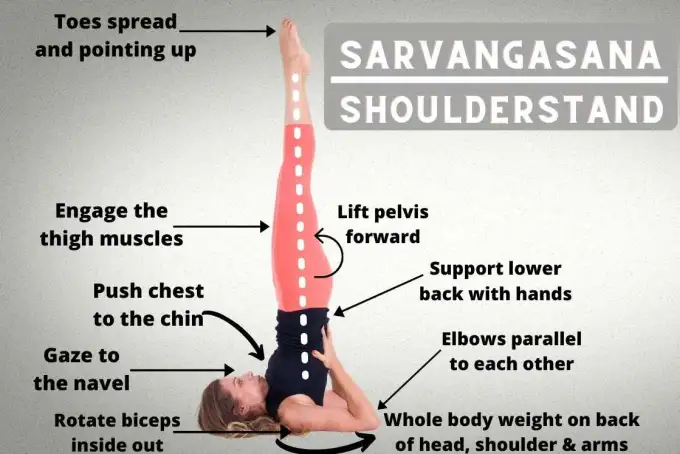
Read over the following information to start practicing Salamba Sarvangasana quickly and safely.
Precautions and Contraindications
- Avoid doing the Sarvangasana if pregnant or having a period. Reversing the blood flow while doing it could be more detrimental than beneficial in this situation.
- Consult a specialist if you have high blood pressure, a heart issue, glaucoma, or a high myopia range.
- This pose should not be performed by anyone who has a sciatic nerve issue, a spine injury, or a shoulder injury.
- When striking the position, don’t jerk because this could really hurt you.
Before doing Sarvangasana, avoid engaging in any strenuous exercise because this could cause too much blood flow to be sent to the brain.
Preparatory Pose
- Bridge Pose (Sethu bandha Sarvangasana)
- Plow Pose (Halasana)
- Hero Pose (Virasana)
Sarvangasana Steps
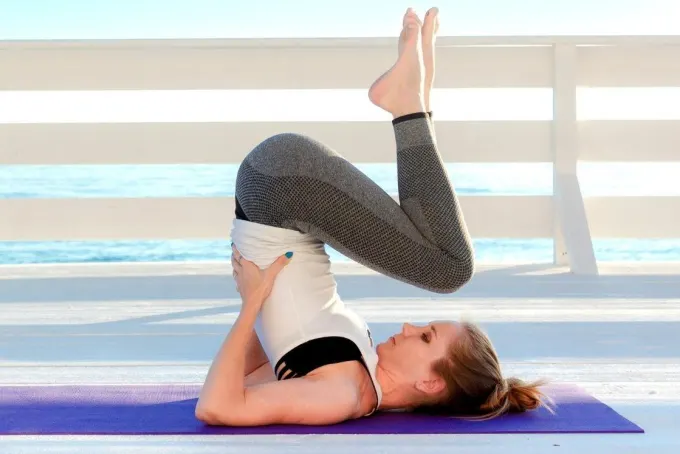
- Lay flat on the mat to start. From the back of your knees to the tips of your toes, extend your legs. Put your hands on the mat, palms down, next to your hips. Breathe slowly.
- Now, flex the knees and twirl your legs up into your tummy while exhaling. Allow your front thighs to lightly touch and press your stomach. Draw a deep breath.
- Exhale one more, then lift your hips off the floor. Bend the arms at the elbows to support the hips. Hips supported by hands. Inhale deeply here.
- As you continue to exhale, lower your hands and elevate your trunk until your chest is level with your chin. Support your middle back now with your hands (both sides of the spine).
- The only parts of the body that should rest on the floor are the backs of the head, neck, shoulders, and upper arms (the area between the elbow and shoulder).
- Finally, extend your legs by opening them up. Toes ought to be pointed upward.
- Maintain a relaxed breathing pattern while positioning your body entirely upward.
- Although the ultimate position is the same as above, the advanced practitioner’s stages include the full plow stance (Halasana).
Release
Hold the Sarvangasana position for at least three to five minutes. However, with effort, this time can be increased to a total of 15 minutes of practice at the conclusion of a yoga session.
If it is comfortable, a trained practitioner can go beyond standard timing. Do not overextend yourself in enthusiasm or skill.
Beginners Tips
- Bring your focus to the area of the pelvis to balance the body in Sarvangasana. Since the body tends to wobble outward from the waist, the pelvic inward movement may be advantageous in this situation.
- Keep in mind that when raising the trunk in the inverted position, you must raise the chest toward the chin rather than the chin toward the chest. The spine will be totally lengthened.
- When your practice of Sarvangasana is finished, avoid standing immediately. Before leaving, one should spend a little period of time lying flat or in Shavasana.
- Verify if the shoulder can hold your weight. The cervical vertebrae, the most vulnerable vertebrae in the spine, should not be subjected to weight bearing.
Check out the changes listed below to make Sarvangasana easier for beginners to practice.
Props and Modification
- Use a folded blanket underneath the neck if you are unable to flatten your head’s back. This will help the neck maintain proper posture.
- Practitioners who struggle to keep their posture might lean their feet on a wall for support. Measure the distance from the wall according to its height (Taller go wider and Shorter go narrower).
- Before beginning the practice of Purna Sarvangasana, one might raise one leg as in Ardha Sarvangasana.
- Before performing Sarvangasana, one can use a strap that is shoulder width and loop it around the forearms to correct elbow sway.
Follow Up Poses
- Corpse Pose (Shavasana)
- Fish pose (Matsyasana)
Sarvangasana Variations
Most variations are available in Sarvangasana’s stance. Along with headstands, there are 66 varieties of shoulder stands in Krishnamacharya’s book Yoga Rahasya.
The following are a few of the most typical variations:
1. Setu Bandha Sarvangasana
It’s known as the bridge pose. In this variation of Sarvangasana, the body comes down from an inverted to a backbend position. Or alternatively,
- After bending your knees in the second step, keep your feet in place at a hip distance rather than spinning up the legs.
- Now, elevate each back individually, starting with the lower back.
- Back support with hands
2. Padma Sarvangasana
In this, legs come in padmasana after reaching the final position of Sarvangasana. It’s called Lotus shoulder stand. To do this,
- In the final position, place your left leg on the right thigh and your right leg on the left thigh.
- Maintain the basic Sarvangasana position.
3. Ardha Padma Sarvangasana
It is the shoulder stand with a half-lotus stance. For this,
- Bend one leg in Sarvangasana and cross it over the thigh of the other leg.
- Maintain the other leg’s erect posture.
- Hold the standard Sarvangasana pose.
4. Eka Pada Sarvangasana
One-Legged Shoulder Stand Pose is what it’s known as. For this,
- To support the Sarvangasana base stance, the hand should be on the floor with the fingers clasped.
- Now, slowly lower your right foot until it touches the ground behind your head. Hold this position. Apply the same technique to the other leg.
5. Parsvaika Pada Sarvangasana
- One leg side is referred to as a Рarsvaika (Parsva + Еka + pada). This variation maintains the base stance while one leg lowers one side to the floor (in line with the trunk). Side One-Legged Shoulder is the name of it.
standing Pose
6. Parsva sarvangasana
The side is referred to as Рarsva. Giving the trunk a lateral twist from the fundamental Sarvangasana stance is how you perform this variant. The stance is known as a side shoulder stand.
Sarvangasana (Shoulder stand) Benefits
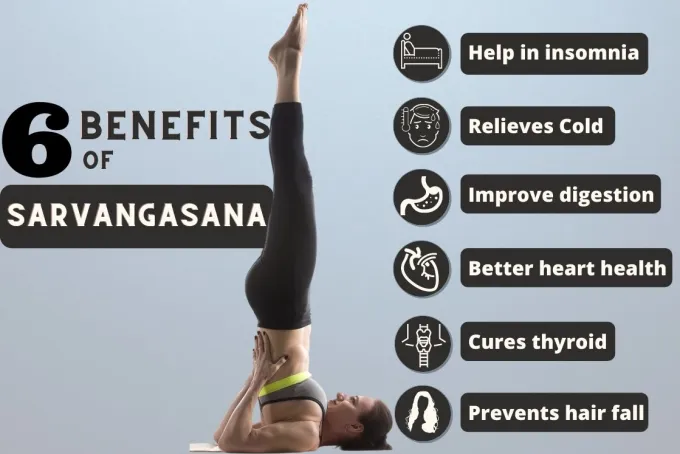
- Thyroid gland issues are resolved because Sarvangasana promotes blood flow to the thyroid gland by applying pressure to it.
A study has demonstrated [efn note] thyroid blood flow monitoring using a Doppler before and after yoga postures.http://njbms.in/uploads/19/1600_pdf.pdf [/efn_note] Sarvangasana dispenses the need for medical treatment and maintains thyroid balance in normal individuals. - Reducing nutritional deficiency (Vegavidharana) has been identified as one of the reasons for hair loss in Ayurvedic medicine. A thorough examination of Kesha and other hair issues in the context of Ayurveda. The position of the shoulders massages the scalp and feeds the hair with nutrients. It strengthens the hair roots and reduces hair loss.
- The head-down, body-up Sarvangasana pose enhances the flow of oxygenated blood to the heart, which helps to improve cardiovascular health. In one study, heart rate, stroke volume, and blood pressure were assessed both before and after practicing the head-down, body-up posture practice known as Sarvangasana. It has been discovered that practicing Sarvangasana considerably enhances the heart’s general function.https://www.ijsrp.org/research-paper-1213/ijsrp-p2422.pdf
- Balance throat chakra – Sarvangasana compresses the neck region and removes any knots causing an imbalance of Vishudhi (throat) chakra. A balanced throat chakra brings purity to your speech and relaxes tense neck muscles.
- Effective in managing diabetes – Sarvangasana practice combined with a certain pranayama can stimulate the endocrine portion of the pancreas responsible for insulin secretion in diabetes mellitus patients. https://www.researchgate.net/
- Increases bowel motions and digestive system effectiveness by altering the gravitational pull of the abdominal organs in an inverted pose like Sarvangasana.
- Beneficial for PMS and recovering fertility Sarvangasana has been demonstrated to be a successful method for helping women live healthy reproductive lives. This pose stops the periodic alterations brought on by premenstrual syndrome or ovulatory cycles (PMS) [efn note] http://indianyoga.org/[/even note] Yoga and Healthy Lifestyle Modification in Premenstrual Syndrome Prevention. It aids in recovering fertility as well. [efn note] Yoga and clomiphene for infertile women: A comparison http://www.earthjournals.in/ijpt_121.pdf [/efn_note] in infertile women.
















